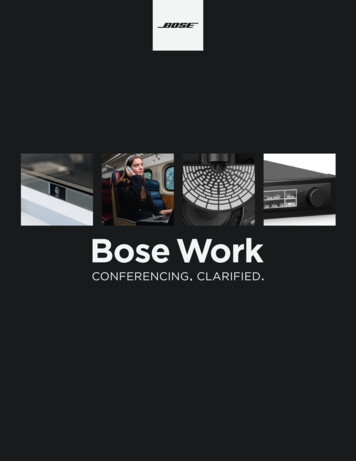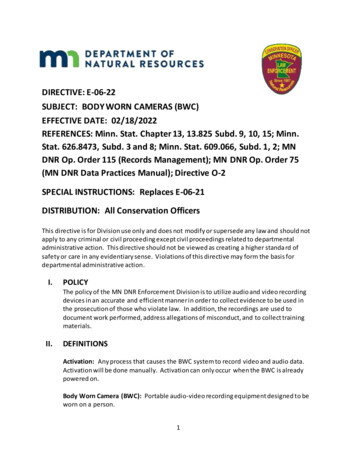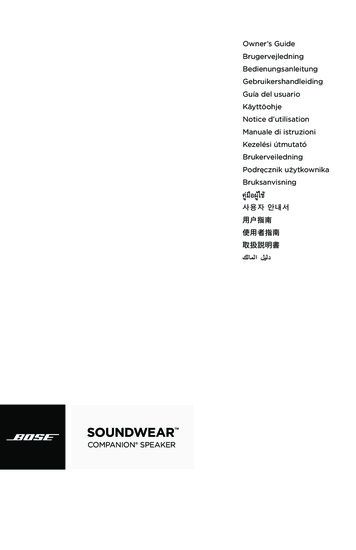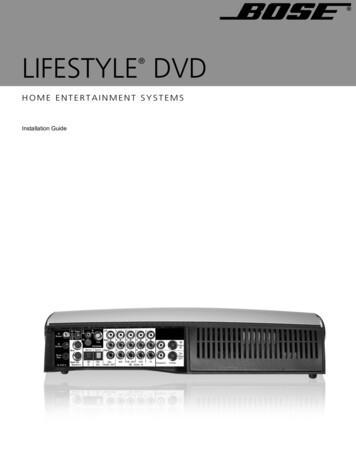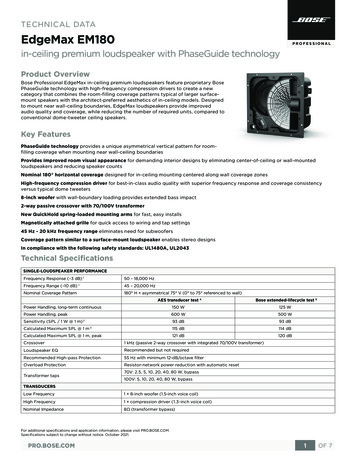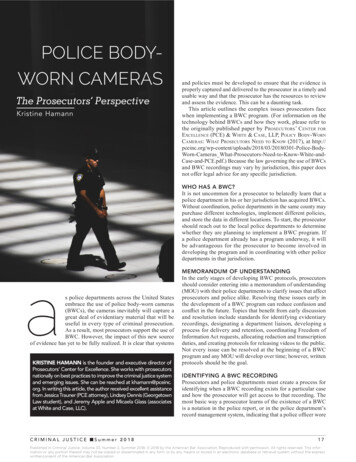
Transcription
BOSE WORKCONFIGURATIONUSER GUIDE
INTRODUCTION . 4System/Browser Requirements . 4Trademark and Licensing Information . 5User Agreement and Privacy Information . 5HOME SCREEN (USB APP ONLY) .6SETTINGS . 7Administrator Settings . 8STATUS TAB . 10CONFIGURATION TAB . 11Firmware . 11Installing Firmware Manually . 11User Access . 12Profile . 13Restoring a Profile . 13Saving the Current Profile. 13Uploading a Profile. 13System . 14Identity . 152
VIDEO TAB. 16Camera . 16Saving New Presets / Changing Presets . 16Viewing Existing Presets . 16Autoframing. 17Image . 18AUDIO TAB . 19Microphones . 19Dynamic Beams . 19Static Beams . 19Adding and Deleting Beams . 20Exclusion Zones. 20Configure Room . 20Audio Controls . 21Meters . 21NETWORK TAB .22Wired . 22Wireless . 23Advanced Wireless Security Settings . 24SNMP Settings . 24API . 253
INTRODUCTIONThe Bose Work Configuration application allows you to control the digital pan-tiltzoom (PTZ) camera, perform software updates, and configure VB1 settings. The mainconfiguration options include:Video settings (pan/tilt/zoom, brightness, contrast, etc.)User settings (autoframe, microphone, etc.)Administration settings (network parameters, Bluetooth connectivity, etc.)Firmware updates (included in Administration settings)Notes:Basic settings, such as PTZ and camera presets, can be configured by any userand do not require a password to make changes. The remaining configurationoptions, including software updates, are available only to administrators andrequire a password for access.To use the HDMI Display port on the VB1, you must enable HDMI output in theUser Access page in the Configuration tab. If you are using Windows, you mustfirst download and install the latest DisplayLink driver.If you are using the Bose Work Configuration app in a browser (the WebUI app),you will also need a USB connection if you wish to see the camera image.System/Browser RequirementsThe Bose Work Configuration app works with the following operating systems andbrowsers:Operating Systems:Microsoft Windows 8 (and higher)macOS 10.12 (and higher)Browsers:Google Chrome , Version 75 (and higher)Microsoft Edge, Version 44 (and higher)Safari , Version 12.1.1 (and higher)Mozilla Firefox, Version 67 (and higher)4
Trademark and Licensing InformationBose, Bose Work, and Videobar are trademarks of Bose Corporation.The Bluetooth word mark and logos are registered trademarks owned by BluetoothSIG, Inc. and any use of such marks by Bose Corporation is under license.DisplayLink is the registered trademark of DisplayLink Corp. in the EU, the US, andother countries.Firefox is a trademark of the Mozilla Foundation in the U.S. and other countries.Google Chrome is a trademark of Google LLC.The term HDMI is a trademark or registered trademark of HDMI LicensingAdministrator, Inc.macOS and Safari are trademarks of Apple Inc., registered in the U.S. and othercountries.Microsoft, Microsoft Edge, and Windows are registered trademarks or trademarks ofMicrosoft Corporation.All other trademarks are the property of their respective owners.User Agreement and Privacy InformationTo view the Bose Work Configuration application user agreement or the BosePrivacy Policy, click the desired link on the Settings page.5
HOME SCREEN (USB APP ONLY)When you connect your computer to theUSB-C-to-PC port on the Bose VideobarVB1, you can open the Bose WorkConfiguration app. The initial screen willbe the Home screen where you can adjustcamera settings.Click the Home Screen icon toaccess this screen fromelsewhere in the app.Note: If the USB connection is notestablished, the screen will show amessage prompting you to check thatthe VB1 is connected to a power outletand to your computer's USB port.The Home screen is accessible to allusers. There are some additional password-protected settings that are available onlyto system administrators.1.Video Stream: Live video stream from the VB1 camera.Note: The camera streams to only one app at a time. If you see a messagethat the video stream is not available, you may have another app openthat is using the camera.2.Camera Pan and Tilt: Click a button once to pan or tilt the camera in increments,or click and hold a button for continuous pan or tilt.3.Autoframe: Turns the autoframe feature on/off. Autoframeautomatically adjusts pan/Tilt/Zoom (PTZ) settings to continuouslyframe all participants in the room. When autoframe is off, the iconappears with a slash through it.Note: Autoframe will be automatically turned off when any of the PTZcamera controls or preset buttons are selected.4.Settings: Click the Settings icon to open the Settings screen. Click theHome Screen icon to return to the Home screen.5.Administrator: Click the Administrator icon to access to the passwordprotected configuration settings in the Bose Work Configuration app.These settings are available only to system administrators.6.Low Light Compensation: Enables/disables automatic low-light compensationto optimize video in dim lighting conditions.7.Presets: There are three Preset buttons (Home, 1, and 2) that you can use toquickly position the camera at predefined pan, tilt, and zoom settings.8.Zoom: Move the slider to the right to zoom the camera in, or to the left to zoomout.9.Volume: Move the slider to the right to increase the audio volume, or to the leftto decrease the volume.6
SETTINGSThe Settings page provides versioninformation for the app itself, the VB1firmware/software, and the VB1 camerasoftware. Links to the latest app andfirmware versions are also provided ifupdates are available.You can access the followingdocumentation by clicking its link: Bose Work Configuration User Guide(user documentation for this app) Bose Videobar VB1 Owner’s Guide(user documentation for the VB1hardware) Bose Work Configuration app End UserLicense Agreement and Terms of Use Bose Privacy PolicyClick the Settings icon in the left pane of any page in the app to access theSettings page.Click the Home Screen icon to return to the Home screen.7
Administrator SettingsThe app contains some password-protectedsettings that are available only to systemadministrators. These settings can beaccessed from the Home screen thatincludes the camera control settings that areaccessible to all users.To access Administrator configurationsettings:1.Click the Administrator icon in thenavigation panel. TheAdministration screen will appear.2.Enter your Administrator password andthen click the Sign In button.Select or deselect the Show Passwordcheckbox to show or hide the password.The first time you log into a VB1, youmust enter the factory defaultpassword of Bose123! to access theAdministrator configuration settings.As a best practice, you should change the password. See Configuration Tab System Device Password for password requirements and instructions onchanging the password.After five unsuccessful login attempts, you must manually reset the VB1 torestore its factory default settings (after which it can accept the factory defaultpassword again). To restore all settings of the VB1 to their factory defaults, doone of the following: (A) on the remote control, press and hold the Home buttonand Autoframe button simultaneously for five seconds; or (B) on the side of theVB1, press and hold the Mute button and Bluetooth button simultaneously forfive seconds.8
The Administration area of the app includes the following tabs: Status: Device information, access to available firmware updates, andaudio, video, and connection status. This tab appears automatically afteryou have successfully logged into the Administrator area. Configuration: Install firmware; configure user access to certain video,audio, and connectivity settings; configure profiles, system settings, andidentification settings. Video: Save/recall camera presets and restore factory default camerasettings; enable/disable autoframe access and configure autoframesettings; and enable/disable automatic low-light compensation andconfigure low-light compensation settings. Audio: Configure the linear microphone array, control access tomicrophone and other audio settings, and view audio input and outputlevels. Network: Enable/disable both wired and wireless connections, configureInternet Protocol (IP) settings for network connections, and configurewireless network security settings.Note: If there is no activity in the app for 30 minutes, a message appears toindicate that you will be logged out after two minutes for security purposes.Click Continue to remain in the app, or click Log Out to close the app.To return to the camera controls/home screen, click the Administrator iconand then click the Sign Out button.9
STATUS TABThe Status tab provides information aboutthe VB1 and connection status: Name: The name that was assigned tothe VB1 (on the Identity page of theConfiguration tab). Profile Name: The unique name of thesaved configuration profile that wasuploaded to the VB1. Firmware Version: The version numberof the installed firmware.The Update Firmware button appearsonly when an update is available. Clickthe button to go to the Firmware page. Camera Version: The version numberof the VB1 camera software. Serial Number: The serial number of the VB1. USB Audio: The Bluetooth audio streaming status: Streaming or Not Streaming. Camera: The camera (video) status: Streaming or Not Streaming. Wired Connection: The status of the wired connection:If a wired connection has not been set up, the status is Disabled.When a wired connection is established, the status is Connected and the IPaddress is displayed as an active link. Click the link to open a browserconnection to the VB1.If a wired connection is established and the signal is lost, the status isDisconnected. Wireless Connection: The status of the wireless connection:If the wireless connection has not been set up, the status is Disabled.When a wireless connection is established, the name of the wireless networkappears and the IP address is displayed as an active link.If a wireless connection is established and the signal is lost, the status isDisconnected. Bluetooth: The Bluetooth connection status: Connected or Not Connected. Ifconnected, the name of the device that is paired to the VB1 is displayed alongwith the BT Audio and BT Call status as either Streaming or Not Streaming.10
CONFIGURATION TABThe Configuration tab includes firmware information and updating features; useraccess to certain video, audio, and connectivity settings; controls to manage profiles,system settings, and identification settings.FirmwareThe Firmware page shows the currentlyinstalled firmware version. If a newer versionof the firmware is available, a message willappear next to an Install button.To install the latest firmware:1.Click the active Install button.You can click the Release Notes arrowto show/hide the release notes for thenew firmware.2.Confirm whether you wish to proceedwith the firmware update by clickingeither Cancel or Continue.Installing Firmware ManuallyThe Firmware page also allows you to install a firmware directly. To do this:1.Under Upload and Install another version, click the Bose Work link to locateand download the firmware version you wish to install.2.In the gray box on the Firmware page, drag and drop or click Browse to locateand select the .swu file for the desired firmware, and then click Install below thegray box.If the installation fails, you will see a message that an error occurred during theinstallation. Click OK to close the dialog box.11
User AccessThe User Access page enables you to specifywhether to grant user access to certainsettings for video, audio, and network andconnectivity.Click the toggle to enable or disable accessto the following Video, Audio, and Network& Connectivity features: VideooCamera: Enables/disables the VB1camera.oAutoframe Access:Enables/disables the ability toturn autoframe on/off.Note: When disabled, autoframewill remain in the off state on theHome screen.o Audioo DisplayLink: Enables/disablesHDMI output/DisplayLink. Thedefault setting is Disabled.Microphone Mute Access: Enables/disables the ability to mute the VB1microphone.Network & ConnectivityoWired Network: Enables/disables wired network connection.oWireless Network: Enables/disables wireless network connection.oSNMP: Enables/disables simple network management protocol (SNMP)over the network.oBluetooth: Enables/disables Bluetooth connectivity.12
ProfileThe Profile page allows you to upload, download, and restore profiles. A profilecontains a unique profile name and may also include an identifying description.Restoring a ProfileThe installed profile, whether it is thefactory default or a newly updated version,appears with an asterisk (*) if it has beenmodified (one or more parameters withinthe profile have been changed).Note: Examples of changes includedisabling Bluetooth connectivity orchanging the wired network mode fromDHCP to static.You can restore a profile to discard allchanges by clicking the Restore button inthe Active Profile section. A message willask if you want to override the current profilewith your changes. Click Cancel to keep yourchanges, or click Restore to discard thechanges and revert to the previous settings.Saving the Current ProfileAfter you change any settings, you can save your changes in a new profile. You canthen upload that profile to other VB1s to save configuration time.To save configuration changes in a new profile, click the Save As button in theDownload Active Profile section. You can then add an identifying description of theprofile to the Profile Description field that appears. This field has a 256-character limit.Uploading a ProfileTo upload a profile to a VB1, in the gray box in the Upload Profile section, drag and dropor click Browse to locate and select the file you want to upload, and then click Apply.Note: Uploading a profile will override any current VB1 settings.13
SystemThe System page contains system settings,system logs, and password settings as wellas controls to restore factory defaultsettings and restart the VB1: CTRL Active: Specify the active state ofthe connected alarm system:High or Low. The default setting is Low. Time Zone: Select the local time zone. NTP Server: Select or enter the IPaddress of a Network Time Protocol(NTP) server. You must be connectedto the network to use an NTP server. Low Power Mode: Enable/disable LowPower Mode. When enabled, the VB1will enter a standby mode with lowpower consumption after being idle fortwo hours. Download Logs: Download system log files. Device Password: Click Change to reset the VB1 password. Enter the newpassword in both the New Password and Confirm Password fields, and thenclick Save.Passwords must contain:o 8–12 characterso an uppercase lettero a lowercase lettero a numbero a special characterAfter five unsuccessful login attempts, you must manually reset the VB1 torestore its factory default settings (after which it can accept the factory defaultpassword again). To restore all settings of the VB1 to their factory defaults, doone of the following: (A) on the remote control, press and hold the Home buttonand Autoframe button simultaneously for five seconds; or (B) on the side of theVB1, press and hold the Mute button and Bluetooth button simultaneously forfive seconds. Restore All Settings to Default: Click Restore Factory Defaults to restore theVB1 to its factory default settings. Restart Device: Click Restart Now to immediately restart the VB1. (You mayneed to scroll down to see this button.)14
IdentityThe Identity page includes user-editablelocation names for the VB1. These namesare useful when viewing and sortingmultiple devices (in multiple locations) inthe Bose Work Management app.You can edit the following fields to providethe identifying information for the VB1:Device NameBuildingFloorRoomCapacity15
VIDEO TABThe Video tab includes controls for directing the camera. autoframing, and imageprocessing.CameraThe Camera page providespan/tilt/zoom (PTZ) controls for thecamera and the ability to save camerapresets. These presets allow users toquickly change the position of acamera.Saving New Presets /Changing PresetsIn the Controls section, adjust the Pan,Tilt, and Zoom settings, click Save asPreset, and then specify if you want tosave it as Preset 1, Preset 2, or Home.Note: Users can also save Preset 1 or2 by pressing and holding thecorresponding preset button on theVB1 remote control for threeseconds, but the Home preset can besaved only in the Administration areaof the app.Viewing Existing PresetsYou can view or recall any existing presets by clicking the View icon thatappears when you hover the mouse over the preset name. This icon will notbe shown if no preset exists.Note: If you try to exit the page without saving changes you have made, amessage will appear warning you about your unsaved changes. Click Cancel toreturn to the Camera page where you can save your changes, or click Leave toexit and discard changes.16
AutoframingThe Autoframing page allows you toenable or disable Autoframe Access, whichallows users to turn the autoframe featureon and off by using the remote control orthe Bose Work app on a mobile device: Autoframe Access: Enable or disableuser access to the autoframe feature. Autoframe On/Off: Click theautoframe icon to turnautoframe on or off.Note: When AutoframeAccess is set to Disabled orif Autoframe is off, theother settings on this pagewill be grayed out. Headroom Adjustment: SelectStanding or Sitting to specify theamount of space between the top ofthe camera frame and a subject'shead. Select Standing for stand-upmeetings and Sitting for all others. Zoom Speed: Select how quickly the VB1 camera zooms in/out when peoplemove in the room: Slow, Normal, or Fast. Pan/Tilt Speed: Select how quickly the VB1 camera pans/tilts when peoplemove in the room: Slow, Normal, or Fast. Autoframe Border Size: Adjusts the border size of the framed image: Small,Normal, or Large. For minimal border (maximum zoom), select Small. Autoframe Information: Click this switch to enable/disable this troubleshootingfeature. When set to Enabled, autoframe objects will be superimposed on thevideo image. These will be visible to the far-end meeting participants and in theself-view.17
ImageThe Image page provides the followingcamera image settings: Low Light Compensation:Select/deselect this button to turnautomatic low-light compensationon/off. When set to On, low-lightcompensation optimizes video in dimlighting conditions.You can set Low Light Compensationto On only when BacklightCompensation is set to Off. Backlight Compensation: Select Low,Medium, or High to set the level ofadjustment to the image exposure inconditions with bright light sources.(For example, BacklightCompensation will better illuminatepeople who are silhouetted in front ofbright lighting.) Select Off to disableBacklight Compensation.If Backlight Compensation is set toLow, Medium, or High, Low LightCompensation will be set to Offautomatically. Antiflicker/Power Line Frequency: Select 50 or 60 specify the AC frequency(in Hz) of lighting in the room; this feature will compensate for any flickeringseen in the video image. Select Off to disable this feature. Brightness: Set the overall lightness/darkness of the image. Contrast: Set the difference between the light and dark areas of the image. Saturation: Set the depth of colors in the image. Sharpness: Set the image clarity. White Balance: Set the balance of color temperature of the light source. SelectAuto to set the balance automatically. Restore Image Settings to Defaults: Restore these settings to their factorydefaults. Video Resolution Overlay: Select/deselect this to enable/disable thistroubleshooting feature. When enabled, the screen resolution will besuperimposed on the video image. This will be visible to the far-end meetingparticipants and in the self-view.18
AUDIO TABThe Audio tab provides access to microphone array settings, audio settings, andaudio input and output levels.MicrophonesThe Microphones page allows you to specify the microphone Beam Type and setbeams (depending upon the beam type) to optimize the detection of peoplespeaking in the room. You can also set exclusion zones to minimize unwanted noise.The microphone beams are overlaid on the live video stream to provide a visualrepresentation of the microphone beam coverage.To view the image in full-screen mode, click the Expand icon.Dynamic BeamsThe default beam type is Dynamic, whichincludes a single beam (a white line) that freelysearches for the loudest sound in the room, andadditional dynamic beams (translucent coloredshapes) that are automatically directed at thepeople speaking in the room.If you have already saved static beams and wantto return to dynamic beams, set the Beam Typeto Dynamic, and then click Save Beams asDynamic once it appears.Static BeamsIn some situations, you can achieve betterperformance by aiming static beams atdesignated speaking locations. In this case, setthe Beam Type to Static, click Beam tomanually add a beam, and then click and dragthe beam to a designated speaking location inthe room.To save these beams, click Save Beams as Static.To cancel, set the Beam Type back to Dynamicor exit the Microphones page.19
Adding and Deleting BeamsTo add a beam, click Beam.To delete a beam, click to select it, and then click the Delete icon (which appearsonly when you select a beam and is the same color as the selected beam).Note: You can create a maximum of four beams. The Beam button will beactive only when there are fewer than four beams.Exclusion ZonesExclusion zones can help minimize unwantednoise by designating areas in which dynamicmicrophone beams will never be directed.By default, two exclusion zones exist and arerepresented by the gray areas at the lowerleft and lower-right sides of the room image.Note: You cannot delete the defaultexclusion zones or make them smaller,but you can make them larger.To add another exclusion zone, click Exclusion Zone, which adds a gray beamto the image.Note: There is a maximum of threeexclusion zones. The Exclusion Zonebutton will active only when there arefewer than three exclusion zones.To increase or decrease the coverage of an exclusion zone, click and drag the edgeof an exclusion zone to the desired angle.To delete an exclusion zone, click to select it, and then click the Delete icon(which appears only when you select an exclusion zone).Configure RoomThe Configure Room settings do not affect theVB1 microphone beams. They change only thelength of the visual representation of the beamsas they appear in the image. You can adjust theWidth and Depth to shorten or lengthen thebeams, which may help when viewing how thebeams intersect with presenters in the room.Note: Click Restore Defaults to restore these settings to their factory defaults.20
Audio ControlsThe Controls page enables you to enable or disable access to the following features: Microphone Mute Access:Enable/disable users' ability to mutethe VB1 microphone. Acoustic Echo Cancellation:Enable/disable Acoustic EchoCancellation (AEC). Room Compensation: Enable/disableaudio processing for rooms that aremore reverberant. Enable this feature toimprove VB1 microphone intelligibility ifused in a reverberant room (e.g., withglass walls). The default is Disabled. Analog Input Gain: Set the gain asneeded to balance the volume of anexternal source with the other audiosources (USB and Bluetooth audiosignal). Speaker Volume: Set the audio level of the VB1 loudspeaker. This setting canalso be adjusted using the computer's volume control, the remote control, or thevolume control on a paired mobile device. Bridged Bluetooth Calls: Enable/disable the ability of Bluetooth calls and mediato bridge to the active UC call. Restore Audio Controls to Defaults: Restore these settings to their factorydefaults.MetersThe Meters page includes audio Input Levelsfor Bluetooth audio, USB audio, and the VB1microphone array as well as Output Levelsfor Bluetooth audio, USB audio, and the VB1loudspeaker.21
NETWORK TABThe Network tab provides access to wired, wireless SNMP, and REST APIconfiguration settings.WiredClick the Status switch on the Wired pageto enable or disable the wired network.You can view and configure the following IPsettings when the wired network is enabled: IP Configuration: Select the IPconfiguration type: DHCP or Static.oDHCP (Dynamic HostConfiguration Protocol)dynamically assigns the IPAddress, Subnet Mask, and othernetwork parameters (whenapplicable) for the VB1.oSelect Static to manually enter anIP Address and Subnet Mask.When you are finished configuringsettings, click Apply.The Apply button (for Static IP configuration) remains inactive until youenter the minimum required information: the IP Address and Subnet Mask.Changes do not take effect until you click Apply.The following optional settings can only be configured when the IP Configuration isset to Static. These settings are read-only when the IP Configuration is set to DHCP.The MAC Address is always read-only. Default Gateway: The IP address for the VB1 used to forward traffic to othernetworks. Primary DNS: The IP address of the primary DNS server that assigns an IPaddress to a VB1. Secondary DNS: The IP address of the primary DNS server that assigns an IPaddress to a VB1 when the Primary DNS server is not available. MAC Address: The media access control address, which is a unique identifyingnumber assigned to the network interface controller (NIC). Restore Defaults: Restore all network settings to their factory defaults.Note: VB1 also supports AutoIP. If IP Configuration is set to DHCP and noDHCP server is found, the VB1 will automatically assign itself an IP address inthe AutoIP range.22
WirelessClick the Status switch on the Wirelesspage to enable or disable the wirelessnetwork.The Network menu includes a list ofavailable networks, the signal strength ofeach network, and a lock icon if the networkis password-protected. If you select aWPA2 network, enter the password in thefield that appears, and then click Join toconnect to the network.After the wireless connection is established,the Status will appear as Connected.You can view and configure the following IPsettings when the wireless network isenabled: IP Configuration: Select the IP configuration type: DHCP or Static.oDHCP (Dynamic Host Configuration Protocol) dynamically assigns the IPAddress, Subnet Mask, and other network parameters (when applicable)for the VB1.oSelect Static to manually enter an IP Address and Subnet Mask. When youare finished configuring settings, click Apply.The Apply button (for Static IP configuration) remains inactive unt
Video Stream: Live video stream from the VB1 camera. Note: The camera streams to only one app at a time. If you see a message that the video stream is not available, you may have another app open that is using the camera. 2. Camera Pan and Tilt: Click a button once to pan or tilt the camera in increments,

